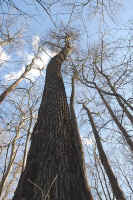ENTS,
I received my new rangefinder in the mail yesterday. I got a
Nikon Monarch 800, which after using a bit today I like very
well. My friend Joe (a recent addition to the listerve) and I
went to a site in Maryland, south of Washington D.C. located on
the Potomac River called Chapman's Landing.
 |
 |
|
site: Chapman's Landing, west side of a knoll west of Mt. Aventine
size: 106.5' x 8'8"
photographer: Darian Copiz
This Sassafras is in a grove of about 4 similarly sized trees. Joe Malandruccolo is in the picture for scale. Behind his left shoulder is another Sassafras. On the
ground is a fallen Sassafras. The second image is
of the same tree taken from the base.
|
This link gives a
description of the site with some tree pictures as well: http://www.chapmanforest.org/bigtrees.html
This was our first time measuring tree heights. I didn't make a
table for the rangefinder, but it is supposed to have a 1/2 yard
accuracy so I don't think distance measurements should be too
far off. I'm using a Suunto clinometer. Generally we measured
degrees to half a degree. I have no idea how anyone can measure
this to a tenth of a degree unless using a tripod on a windless
day. As this was our first day measuring, and there were no
veteran ENTS to verify our measuring I expect the below
measurements are tentative. However, we did feel fairly
confident that these figures give a pretty good idea of the
heights. On some of the trees we may have missed the tallest
twig, but most of the time were probably pretty close.
Chapman's Landing:
Carya cordiformis 8'0"
x 126.5' edge of
top of ravine
Carya cordiformis 9'9"
x 118.8' edge of
top of ravine
Carya glabra 9'0"
x 114.1' edge of
top of ravine
Fagus grandifolia 8'2"
x 108.4' gentle
slope of ravine
Fraxinus pennsylvanica 10'2" x
120.5' edge of top of
ravine
Fraxinus pennsylvanica 11'1" x
107.2' flat upland area
Liriodendron tulipifera 17'5" x
113.8' x 60' the last number is horizontal spread in one
direction from trunk base. on a shallow slope of a ravine.
Liriodendron tulipifera 133',
circumference was not measured but the dbh appeared to be about
a pitiful 2'. growing in the bottom of a ravine.
Platanus occidentalis 118.7,
circumference was not measured but was even more wimpy than the
unmeasured tulip tree. growing in the bottom of a ravine.
Quercus muhlenbergii 12'9"
x 90.0' top of a
knoll
Sassafras albidum 8'8"
x 106.5' slope of
knoll
At another site just upriver, Ruth B. Swann Memorial Park we
also measured a beech tree, but based off of measurements of
later beeches that looked taller we were slightly skeptical of
the height measurement
Fagus grandifolia 9'5"
x 129.4' on slope
above small stream
The tallest tree measured (tulip tree) with the exception of the
sycamore was the least impressive tree we measured. These two
trees were cheating by growing at the bottom of the ravine which
not only gave them access to richer soils, but also forced them
to compete with trees growing higher up on the ravine slopes.
These two trees also had small crowns. We didn't see any really
big trees in the ravine bottoms.
We did not have as much time as we would have liked and only
covered a portion of the site. We would definitely like to go
back sometime. The Q. muhlenbergii in the picture on the above
referenced website is one I would especially like to find. Who
knows what the height is, but that's an impressive tree.
Darian
|